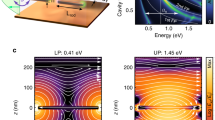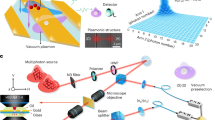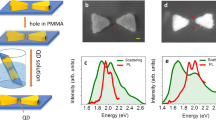Abstract
Cooperative coupling between optical emitters and light fields is one of the outstanding goals in quantum technology. It is both fundamentally interesting for the extraordinary radiation properties of the participating emitters and has many potential applications in photonics. Although this goal has been achieved using high-finesse optical cavities, attention has turned to broadband, easy to build cavity-free approaches. Here we demonstrate cooperative coupling of ultracold atoms with surface plasmons propagating on a plane gold surface. While the atoms are moving towards the surface they are excited by an external laser pulse. The interaction between the excited atom fluorescence and surface plasmons is probed by detecting the photons emitted into the substrate when the plasmon excitations decay. A maximum Purcell factor of ηP = 4.9 is reached at an optimum distance of z = 250 nm from the surface. The coupling leads to the observation of a Fano-like resonance in the spectrum.
This is a preview of subscription content, access via your institution
Access options
Subscribe to this journal
Receive 12 print issues and online access
$209.00 per year
only $17.42 per issue
Buy this article
- Purchase on Springer Link
- Instant access to full article PDF
Prices may be subject to local taxes which are calculated during checkout




Similar content being viewed by others
References
Haroche, S. & Raimond, J-M. Exploring the Quantum: Atoms, Cavities, Photons (Oxford Univ. Press, 2006).
Imamoglu, A. & Yamamoto, Y. Turnstile device for heralded single photons: Coulomb blockade of electron and hole tunneling in quantum confined p–i–n heterojunctions. Phys. Rev. Lett. 72, 210–213 (2011).
Kim, J., Benson, O., Kan, H. & Yamamoto, Y. A single-photon turnstile device. Nature 397, 500–503 (1999).
He, Y-M. et al. On-demand semiconductor single-photon source with near-unity indistinguishability. Nature Nanotech. 8, 213–217 (2013).
Englund, D. et al. Controlling the spontaneous emission rate of single quantum in a two-dimensional photonic crystal. Phys. Rev. Lett. 95, 013904 (2005).
Yamamoto, Y. & Imamoglu, A. Mesoscopic Quantum Optics (Wiley, 1999).
Birnbaum, K. M. et al. Photon blockade in an optical cavity with one trapped atom. Nature 436, 87–90 (2005).
Peyronel, T. et al. Quantum nonlinear optics with single photons enabled by strongly interacting atoms. Nature 488, 57–60 (2012).
Volz, T. et al. Ultrafast all-optical switching by single photons. Nature Photon. 6, 605–609 (2012).
Chang, D. E., Sørensen, A. S., Demler, E. A. & Lukin, M. D. A single-photon transistor using nanoscale surface plasmons. Nature Phys. 3, 807–812 (2007).
Neumeier, L. et al. Single-photon transistor in circuit quantum electrodynamics. Phys. Rev. Lett. 111, 063601 (2013).
Kimble, H. J. Strong interactions of single atoms and photons in cavity qed. Phys. Scr. T 76, 127–137 (1998).
Khitrova, G., Gibbs, H. M., Kira, M., Koch, S. W. & Scherer, A. Vacuum Rabi splitting in semiconductors. Nature Phys. 2, 81–90 (2006).
Benson, O. Assembly of hybrid photonic architectures from nanophotonic constituents. Nature 480, 193–199 (2011).
Törmä, P. & Barnes, W. L. Strong coupling between surface plasmon polaritons and emitters. Preprint at http://arXiv.org/abs/1405.1661 (2014).
Barnes, W. L., Dereux, A. & Ebbesen, T. W. Surface plasmon subwavelength optics. Nature 424, 824–830 (2003).
Gramotnev, D. K. & Bozhevolnyi, S. I. Plasmonics beyond the diffraction limit. Nature Photon. 4, 83–91 (2010).
Schuller, J. A. et al. Plasmonics for extreme light concentration and manipulation. Nature Mater. 9, 193–204 (2010).
Weber, W. H. & Eagen, C. F. Energy transfer from an excited dye molecule to the surface plasmons of an adjacent metal. Opt. Lett. 4, 236–238 (1979).
Pockrand, I. & Brillante, A. Nonradiative decay of excited molecules near a metal surface. Chem. Phys. Lett. 69, 499–504 (1980).
Chang, D. E., Sørensen, A. S., Hemmer, P. R. & Lukin, M. D. Quantum optics with surface plasmons. Phys. Rev. Lett. 97, 053002 (2006).
Tame, M. S. et al. Quantum plasmonics. Nature Phys. 9, 329–340 (2013).
Amos, R. M. & Barnes, W. L. Modification of the spontaneous emission rate of Eu3+ ions close to a thin metal mirror. Phys. Rev. B 55, 7249–7254 (1997).
Anger, P., Bharadwaj, P. & Novotny, L. Enhancement and quenching of single-molecule fluorescence. Phys. Rev. Lett. 96, 113002 (2006).
Andersen, M. L., Stobbe, S., Sørensen, A. S. & Lodahl, P. Strongly modified plasmons–matter interaction with mesoscopic quantum emitters. Nature Phys. 7, 215–218 (2010).
Akimov, A. V. et al. Generation of single optical plasmons in metallic nanowires coupled to quantum dots. Nature 450, 402–406 (2007).
Huck, A., Kumar, S., Shakoor, A. & Andersen, U. L. Controlled coupling of a single nitrogen–vacancy center to a silver nanowire. Phys. Rev. Lett. 106, 096801 (2011).
Bellessa, J., Bonnand, C. & Plenet, J. C. Strong coupling between surface plasmons and excitons in an organic semiconductor. Phys. Rev. Lett. 93, 036404 (2004).
Dintinger, J., Klein, S., Bustos, F., Barnes, W. L. & Ebbesen, T. W. Strong coupling between surface plasmon–polaritons and organic molecules in subwavelength hole arrays. Phys. Rev. B 71, 035424 (2005).
Vasa, P. et al. Coherent exciton-surface-plasmon–polariton interaction in hybrid metal-semiconductor nanostructures. Phys. Rev. Lett. 101, 116801 (2008).
Hakala, T. K. et al. Vacuum Rabi splitting and strong-coupling dynamics for surface-plasmon polaritons and rhodamine 6G molecules. Phys. Rev. Lett. 103, 053602 (2009).
Gómez, D. E., Vernon, K. C., Mulvaney, P. & Davis, T. J. Surface plasmon mediated strong exciton–photon coupling in semiconductor nanocrystals. Nano Lett. 10, 274–278 (2010).
Schwartz, T., Hutchison, J. A., Genet, C. & Ebbesen, T. W. Reversible switching of ultrastrong light-molecule coupling. Phys. Rev. Lett. 106, 196405 (2011).
Aberra Guebrou, S. et al. Coherent emission from a disordered organic semiconductor induced by strong coupling with surface plasmons. Phys. Rev. Lett. 108, 066401 (2012).
González-Tudela, A., Huidobro, P. A., Martín-Moreno, C. & García-Vidal, F. J. Theory of strong coupling between quantum emitters and propagating surface plasmons. Phys. Rev. Lett. 110, 126801 (2013).
Chang, D. E. et al. Trapping and manipulation of isolated atoms using nanoscale plasmonic structures. Phys. Rev. Lett. 103, 123004 (2009).
Murphy, B. & Hau, L. V. Electro-optical nanotraps for neutral atoms. Phys. Rev. Lett. 102, 033003 (2009).
Gullans, M. et al. Nanoplasmonic lattices for ultracold atoms. Phys. Rev. Lett. 109, 235309 (2012).
Righini, M., Zelenina, A. S., Girard, C. & Quidant, R. Parallel and selective trapping in a patterned plasmonic landscape. Nature Phys. 3, 477–480 (2007).
Anderson, M. H., Ensher, J. R., Matthews, M. R., Wieman, C. E. & Cornell, E. A. Observation of Bose–Einstein condensation in a dilute atomic vapor. Science 269, 198–201 (1995).
Fortágh, J. & Zimmermann, C. Magnetic microtraps for ultracold atoms. Rev. Mod. Phys. 79, 235–289 (2007).
Grimm, R., Weidemüller, M. & Ovchinnikov, Y. B. Optical dipole traps for neutral atoms. Adv. At. Mol. Opt. Phys. 42, 95–170 (2000).
Wilk, T. et al. Entanglement of two individual neutral atoms using Rydberg blockade. Phys. Rev. Lett. 104, 010502 (2010).
Juliá-Díaz, B., Graß, T., Dutta, O., Chang, D. E. & Lewenstein, M. Engineering p-wave interactions in ultracold atoms using nanoplasmonic traps. Nature Commun. 4, 2046 (2013).
Chang, D. E., Cirac, J. I. & Kimble, H. J. Self-organization of atoms along a nanophotonic waveguide. Phys. Rev. Lett. 110, 113606 (2013).
Thompson, J. D. et al. Coupling a single trapped atom to a nanoscale optical cavity. Science 340, 1202–1205 (2013).
Goban, A. et al. Atom–light interactions in photonic crystals. Nature Commun. 5, 3808 (2014).
Esslinger, T., Weidemüller, M., Hemmerich, A. & Hänsch, T. W. Surface-plasmon mirror for atoms. Opt. Lett. 18, 450–452 (1993).
Feron, S. et al. Reflection of metastable neon atoms by a surface plasmon wave. Opt. Commun. 102, 83–88 (1993).
Schneble, D., Hasuo, M., Anker, T., Pfau, T. & Mlynek, J. Detection of cold metastable atoms at a surface. Rev. Sci. Instrum. 74, 2685–2689 (2003).
Stehle, C. et al. Plasmonically tailored micropotentials for ultracold atoms. Nature Photon. 5, 494–498 (2011).
Hohenau, A. et al. Surface plasmon leakage radiation microscopy at the diffraction limit. Opt. Express 19, 25749–25762 (2011).
Raether, H. Surface Plasmons on Smooth and Rough Surfaces and on Gratings (Springer, 1988).
Chance, R. R., Prock, A. & Silbey, R. Molecular fluorescence and energy transfer near interfaces. Adv. Chem. Phys. 37, 1–65 (1978).
Sipe, J. E. The dipole antenna problem in surface physics: A new approach. Surf. Sci. 105, 489–504 (1981).
Chang, D. E., Sørensen, A. S., Hemmer, P. R. & Lukin, M. D. Strong coupling of single emitters to surface plasmons. Phys. Rev. B 76, 035420 (2007).
Tanji-Suzuki, H. et al. Interaction between atomic ensembles and optical resonators: Classical description. Adv. At. Mol. Opt. Phys. 60, 201–237 (2011).
Fano, U. Effects of configuration interaction on intensities and phase shifts. Phys. Rev. 124, 1866–1878 (1961).
Fan, P., Yu, Z., Fan, S. & Brongersma, M. L. Optical Fano resonance of an individual semiconductor nanostructure. Nature Mater. 13, 471–475 (2014).
Cohen-Tannoudji, C., Dupont-Roc, J. & Grynberg, G. Atom–Photon Interactions, Basic Processes and Applications (Wiley, 1992).
Choquette, J. J., Marzlin, K-P. & Sanders, B. C. Superradiance, subradiance, and suppressed superradiance of dipoles near a metal interface. Phys. Rev. A 82, 023827 (2010).
Acknowledgements
C.Z. gratefully acknowledges financial support by the DFG. C.S. was supported by Carl-Zeiss Stiftung Baden-Württemberg. S.S. is indebted to the Baden-Württemberg Stiftung for the financial support of this research project by the Eliteprogramm for Postdocs.
Author information
Authors and Affiliations
Contributions
C.Z. provided the laboratory and experimental facilities, C.S. made the measurements, and S.S. analysed the data and wrote the paper.
Corresponding author
Ethics declarations
Competing interests
The authors declare no competing financial interests.
Supplementary information
Supplementary Information
Supplementary Information (PDF 469 kb)
Rights and permissions
About this article
Cite this article
Stehle, C., Zimmermann, C. & Slama, S. Cooperative coupling of ultracold atoms and surface plasmons. Nature Phys 10, 937–942 (2014). https://doi.org/10.1038/nphys3129
Received:
Accepted:
Published:
Issue Date:
DOI: https://doi.org/10.1038/nphys3129
This article is cited by
-
Multifunctional logic gates based on resonant transmission at atomic-plasmonic structure
Scientific Reports (2022)
-
Trace of evanescent wave polarization by atomic vapor spectroscopy
Scientific Reports (2021)
-
Surface Plasmon Polaritons Probed with Cold Atoms
Plasmonics (2018)



